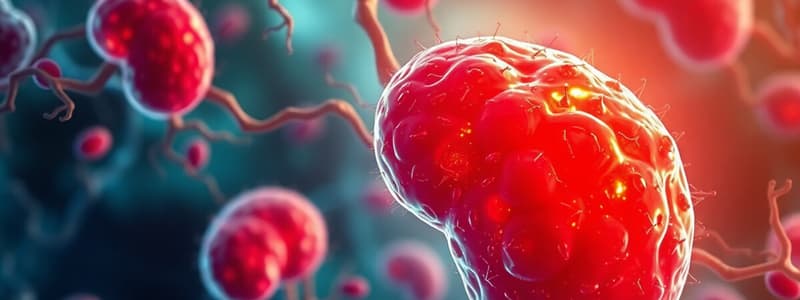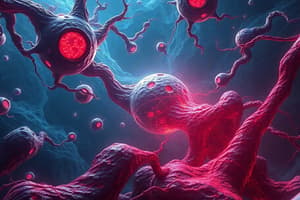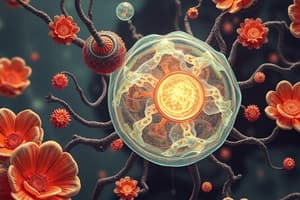Podcast
Questions and Answers
What is associated with massive apoptosis in the liver?
What is associated with massive apoptosis in the liver?
- Ischemic conditions and hypo perfusion (correct)
- Increased bile acid synthesis
- Chronic liver disease only
- Neoplastic cell growth
Which pathway is linked to caspase-dependent apoptosis?
Which pathway is linked to caspase-dependent apoptosis?
- Both A and C (correct)
- Extrinsic pathway
- Intrinsic pathway
- Necroptosis pathway
What triggers mitochondrial external membrane permeabilization during apoptosis?
What triggers mitochondrial external membrane permeabilization during apoptosis?
- Increase in TNF Alpha
- Intrinsic signaling defects
- Endoplasmic reticulum stress (correct)
- Activation of death receptors
What is typically observed in hepatocytes during acute liver injury?
What is typically observed in hepatocytes during acute liver injury?
What can be seen in normal necrosis that is not characteristic of typical apoptosis?
What can be seen in normal necrosis that is not characteristic of typical apoptosis?
What role do smac/DIABLO and cytochrome C play in cell death?
What role do smac/DIABLO and cytochrome C play in cell death?
What type of liver disease is primarily associated with cytotoxic T cells?
What type of liver disease is primarily associated with cytotoxic T cells?
Which of the following statements about hepatocytes is false?
Which of the following statements about hepatocytes is false?
Which of the following triggers the release of profibrogenic cytokines in hepatocyte response to injury?
Which of the following triggers the release of profibrogenic cytokines in hepatocyte response to injury?
What is the primary difference between intrinsic and extrinsic apoptosis?
What is the primary difference between intrinsic and extrinsic apoptosis?
What is a key consequence of massive apoptosis in liver tissue?
What is a key consequence of massive apoptosis in liver tissue?
What distinguishes reversible hepatocellular injury from irreversible injury?
What distinguishes reversible hepatocellular injury from irreversible injury?
Which of the following is a characteristic of reversible hepatocellular injury?
Which of the following is a characteristic of reversible hepatocellular injury?
What cellular process is primarily responsible for repairing liver injury?
What cellular process is primarily responsible for repairing liver injury?
What is the primary difference between necrosis and apoptosis?
What is the primary difference between necrosis and apoptosis?
Which condition is associated with microsteatosis?
Which condition is associated with microsteatosis?
What phenomenon is linked to ischemic-hypoxic injury in liver cells?
What phenomenon is linked to ischemic-hypoxic injury in liver cells?
What role do Kupffer cells play in apoptosis?
What role do Kupffer cells play in apoptosis?
What leads to necrosis during hepatocyte injury?
What leads to necrosis during hepatocyte injury?
Which pathway primarily induces apoptosis via death receptors?
Which pathway primarily induces apoptosis via death receptors?
Which factor is essential for the survival and proliferation of mature liver cells?
Which factor is essential for the survival and proliferation of mature liver cells?
What is a key feature of ballooning degeneration in hepatocellular injury?
What is a key feature of ballooning degeneration in hepatocellular injury?
Which factor is NOT typically associated with reversible hepatocellular injury?
Which factor is NOT typically associated with reversible hepatocellular injury?
Which of the following statements best describes necrosis?
Which of the following statements best describes necrosis?
What is the primary role of hepatocytes in relation to progenitor cells during chronic injury?
What is the primary role of hepatocytes in relation to progenitor cells during chronic injury?
What effect does fibrosis have on hepatocyte remodeling?
What effect does fibrosis have on hepatocyte remodeling?
Which of the following is NOT a type of collagen mentioned in relation to the liver's extracellular matrix?
Which of the following is NOT a type of collagen mentioned in relation to the liver's extracellular matrix?
What does the presence of c-kit indicate in the context of liver repair?
What does the presence of c-kit indicate in the context of liver repair?
Which of the following extracellular matrix components is categorized as non-fibrillary?
Which of the following extracellular matrix components is categorized as non-fibrillary?
In the context of hepatic fibrogenesis, what does an increase/change in the extracellular matrix typically precede?
In the context of hepatic fibrogenesis, what does an increase/change in the extracellular matrix typically precede?
Which cellular marker indicates an active biliary proliferation during liver repair?
Which cellular marker indicates an active biliary proliferation during liver repair?
What is a characteristic of the liver in a ‘streaming liver’ state following chronic injury?
What is a characteristic of the liver in a ‘streaming liver’ state following chronic injury?
What triggers hepatocytes to enter the cell cycle in response to liver injury?
What triggers hepatocytes to enter the cell cycle in response to liver injury?
Which cell type is primarily responsible for secreting TNF-alpha during liver injury?
Which cell type is primarily responsible for secreting TNF-alpha during liver injury?
In cases of chronic liver injury, what is the primary source of liver regeneration?
In cases of chronic liver injury, what is the primary source of liver regeneration?
What is the significance of the G0 phase in hepatocytes?
What is the significance of the G0 phase in hepatocytes?
Which cytokine exclusively binds to hepatocyte receptors to stimulate regeneration?
Which cytokine exclusively binds to hepatocyte receptors to stimulate regeneration?
What is a possible effect of telomere shortening in hepatocytes during liver regeneration?
What is a possible effect of telomere shortening in hepatocytes during liver regeneration?
Which factor is NOT directly involved in the liver regeneration process after acute injury?
Which factor is NOT directly involved in the liver regeneration process after acute injury?
What initial step occurs when Kupfer cells encounter apoptotic or necrotic cells?
What initial step occurs when Kupfer cells encounter apoptotic or necrotic cells?
What is the primary consequence of Ito cell activation during liver damage?
What is the primary consequence of Ito cell activation during liver damage?
Which process occurs as a result of high sinusoidal pressure in liver damage?
Which process occurs as a result of high sinusoidal pressure in liver damage?
Which of the following statements is true regarding capillarization in liver disease?
Which of the following statements is true regarding capillarization in liver disease?
What is a key characteristic of porto-systemic shunts formed during portal hypertension?
What is a key characteristic of porto-systemic shunts formed during portal hypertension?
Which of the following is NOT a consequence of microvascular rearrangement in liver damage?
Which of the following is NOT a consequence of microvascular rearrangement in liver damage?
What role does chronic inflammation play in hepatic fibrogenesis?
What role does chronic inflammation play in hepatic fibrogenesis?
Nodulation in the liver can result from which underlying condition?
Nodulation in the liver can result from which underlying condition?
What is one consequence of portal/vascular fibrosis in liver damage?
What is one consequence of portal/vascular fibrosis in liver damage?
How does hypoxia influence the process of liver fibrosis?
How does hypoxia influence the process of liver fibrosis?
Which of the following best explains the relationship between vascular changes and ischemic injury in the liver?
Which of the following best explains the relationship between vascular changes and ischemic injury in the liver?
Flashcards
Balooning Degeneration
Balooning Degeneration
A reversible form of liver cell injury characterized by swelling of hepatocytes.
Mallory-Denk Bodies
Mallory-Denk Bodies
Cellular inclusions (damaged proteins) in hepatocytes associated with liver injury, often seen in alcoholic liver disease.
Hepatocellular Necrosis
Hepatocellular Necrosis
Pathological cell death in liver cells, occurring due to severe injury.
Apoptosis
Apoptosis
Signup and view all the flashcards
Necrosis
Necrosis
Signup and view all the flashcards
Reversible Hepatocellular injury
Reversible Hepatocellular injury
Signup and view all the flashcards
Steatosis
Steatosis
Signup and view all the flashcards
Apoptosis Pathways
Apoptosis Pathways
Signup and view all the flashcards
Hepatocyte Apoptosis
Hepatocyte Apoptosis
Signup and view all the flashcards
Acute Liver Injury
Acute Liver Injury
Signup and view all the flashcards
Chronic Liver Injury
Chronic Liver Injury
Signup and view all the flashcards
Extrinsic Pathway
Extrinsic Pathway
Signup and view all the flashcards
Intrinsic Pathway
Intrinsic Pathway
Signup and view all the flashcards
Mitochondrial Function Defect
Mitochondrial Function Defect
Signup and view all the flashcards
Apoptosis in Liver Disease
Apoptosis in Liver Disease
Signup and view all the flashcards
Necrosis in Liver Injury
Necrosis in Liver Injury
Signup and view all the flashcards
Hepatocyte Survival Time
Hepatocyte Survival Time
Signup and view all the flashcards
Liver Regeneration
Liver Regeneration
Signup and view all the flashcards
Chronic Liver Damage Triggers
Chronic Liver Damage Triggers
Signup and view all the flashcards
Toxic Liver Damage
Toxic Liver Damage
Signup and view all the flashcards
Fibrogenesis in Liver Diseases
Fibrogenesis in Liver Diseases
Signup and view all the flashcards
HSC Role in Liver Damage
HSC Role in Liver Damage
Signup and view all the flashcards
Hepatocyte Regeneration
Hepatocyte Regeneration
Signup and view all the flashcards
Kupffer Cells
Kupffer Cells
Signup and view all the flashcards
Cell Cycle Stimulation
Cell Cycle Stimulation
Signup and view all the flashcards
TNF-alpha
TNF-alpha
Signup and view all the flashcards
Interleukin-6 (IL-6)
Interleukin-6 (IL-6)
Signup and view all the flashcards
Acute Liver Injury Regeneration
Acute Liver Injury Regeneration
Signup and view all the flashcards
Chronic Liver Injury Regeneration
Chronic Liver Injury Regeneration
Signup and view all the flashcards
G0 Phase
G0 Phase
Signup and view all the flashcards
Progenitor Cell Role
Progenitor Cell Role
Signup and view all the flashcards
Fibrosis and Regeneration
Fibrosis and Regeneration
Signup and view all the flashcards
ECM: Building Blocks of the Liver
ECM: Building Blocks of the Liver
Signup and view all the flashcards
ECM Components
ECM Components
Signup and view all the flashcards
ECM in Liver Function
ECM in Liver Function
Signup and view all the flashcards
ECM Changes in Liver Disease
ECM Changes in Liver Disease
Signup and view all the flashcards
Hepatic Fibrogenesis
Hepatic Fibrogenesis
Signup and view all the flashcards
Capillarization
Capillarization
Signup and view all the flashcards
Sinusoidal Pressure
Sinusoidal Pressure
Signup and view all the flashcards
Shunt Formation
Shunt Formation
Signup and view all the flashcards
Portal Hypertension
Portal Hypertension
Signup and view all the flashcards
HSC Activation
HSC Activation
Signup and view all the flashcards
Neoangiogenesis
Neoangiogenesis
Signup and view all the flashcards
Parenchymal Loss Lesions (PLL)
Parenchymal Loss Lesions (PLL)
Signup and view all the flashcards
Nodulation
Nodulation
Signup and view all the flashcards
Cirrhosis
Cirrhosis
Signup and view all the flashcards
Study Notes
Morphologic Patterns of Hepatic Injury and Cirrhosis
- The presentation is about the morphological patterns of hepatic injury and cirrhosis, focusing on regeneration and fibrogenesis.
- The discussion revolves around reversible and irreversible hepatic injury.
Hepatocellular Injury
- Reversible injury includes ballooning degeneration, Mallory-Denk bodies, and steatosis.
- Irreversible injury includes apoptosis and necrosis.
Reversible Injury
- Ballooning Degeneration: Characterized by intracellular calcium increase, water influx, and membrane volume control derangement leading to hepatocyte swelling. ATP depletion is a major factor.
- Mallory-Denk Bodies: Result from abnormal protein accumulation within hepatocytes, potentially progressing from reversible to irreversible changes, often associated with keratin cytoskeleton alterations.
- Steatosis: Fatty liver disease, characterized by fat accumulation within hepatocytes. Multiple causes exist, including viral hepatitis, autoimmune diseases, drugs, metabolic disorders, starvation, and total parenteral nutrition.
Irreversible Injury
- Apoptosis: Programmed cell death with specific stimuli leading to a degradation cascade, characterized by chromatin condensation, DNA fragmentation, and cellular shrinkage.
- Necrosis: Pathologic cell death due to metabolic degradation, typically involving intracellular calcium increase, ATP depletion, and cell swelling.
- Oncotic Necrosis: A type of necrosis that results from swelling of the cells due to an inadequate supply of ATP.
Cell Death
- Necrosis: Pathologic death characterized by cell membrane damage, swelling, and intracellular content leakage.
- Apoptosis: Programme cell death. Apoptotic bodies form and are removed.
- Necroptosis: A regulated form of necrosis.
- Apoptosis is a form of programmed cell death.
Hepatic Repair
- Regeneration: Liver repair involves mature liver cell proliferation and stem cell/progenitor cell proliferation and differentiation.
- Fibrogenesis: Fibrosis occurs when collagen accumulates in the liver, impeding its normal function and structure.
Mechanisms of Hepatic Fibrosis
- Inflammatory and fibrotic response triggered by apoptotic cells releasing ATP and UDP, stimulating macrophages and HSCs (hepatic stellate cells) . HSCs then release TGF-β, promoting fibrogenesis.
- Fibrosis includes changes to ECM (extracellular matrix) density, profile, and distribution, with an increase in Type I and III collagen, as well as septa formation and lobular/sinusoidal collagen accumulation, causing dysfunction.
- Inflammation, apoptosis, and reactive oxygen species contribute to hepatocyte injury and HSC activation, initiating fibrogenesis.
- Active HSCs release profibrogenic cytokines, including TGF-β, promoting chronic liver injury and fibrosis.
Microvascular Rearrangement
- Increase in endothelial permeability.
- Formation of vascular shunts.
- Vascular thrombosis and obstruction.
- Capillarization of sinusoids.
Neovascularization
- Chronic inflammation, hypoxia (low oxygen), and fibrosis stimulate angiogenesis (new blood vessel formation) in the liver.
- Hepatocyte and Kupffer cell-derived cytokines, such as HIF-1, promote neoangiogenesis.
Portal/hepatic vein branch or sinusoidal obstruction
- Portal or hepatic vein branch or sinusoidal obstruction leads to focal ischemic injury
- Injured hepatocytes appear prior to the fibrotic septa.
- Loss of parenchymal cells can occur.
- Fibrosis development is observed in these areas.
Nodulation
- Micronodular lesions (< 3mm) are often associated with alcoholic liver disease, metabolic disease, and venous outflow obstruction.
- Macronodular lesions (> 3mm) are frequently related to viral hepatitis, autoimmune hepatitis, and other chronic liver conditions.
Additional Points
- Specific cell types play crucial roles in liver fibrosis, including hepatic stellate cells, portal myofibroblasts, and endothelial cells.
- The development of fibrosis and cirrhosis can be triggered by various factors, such as alcohol, viral infections, autoimmune diseases, and metabolic conditions.
- The progression of liver damage can often lead to cirrhosis, characterized by widespread fibrosis, nodular regeneration, and architectural distortion, affecting liver function.
Studying That Suits You
Use AI to generate personalized quizzes and flashcards to suit your learning preferences.




